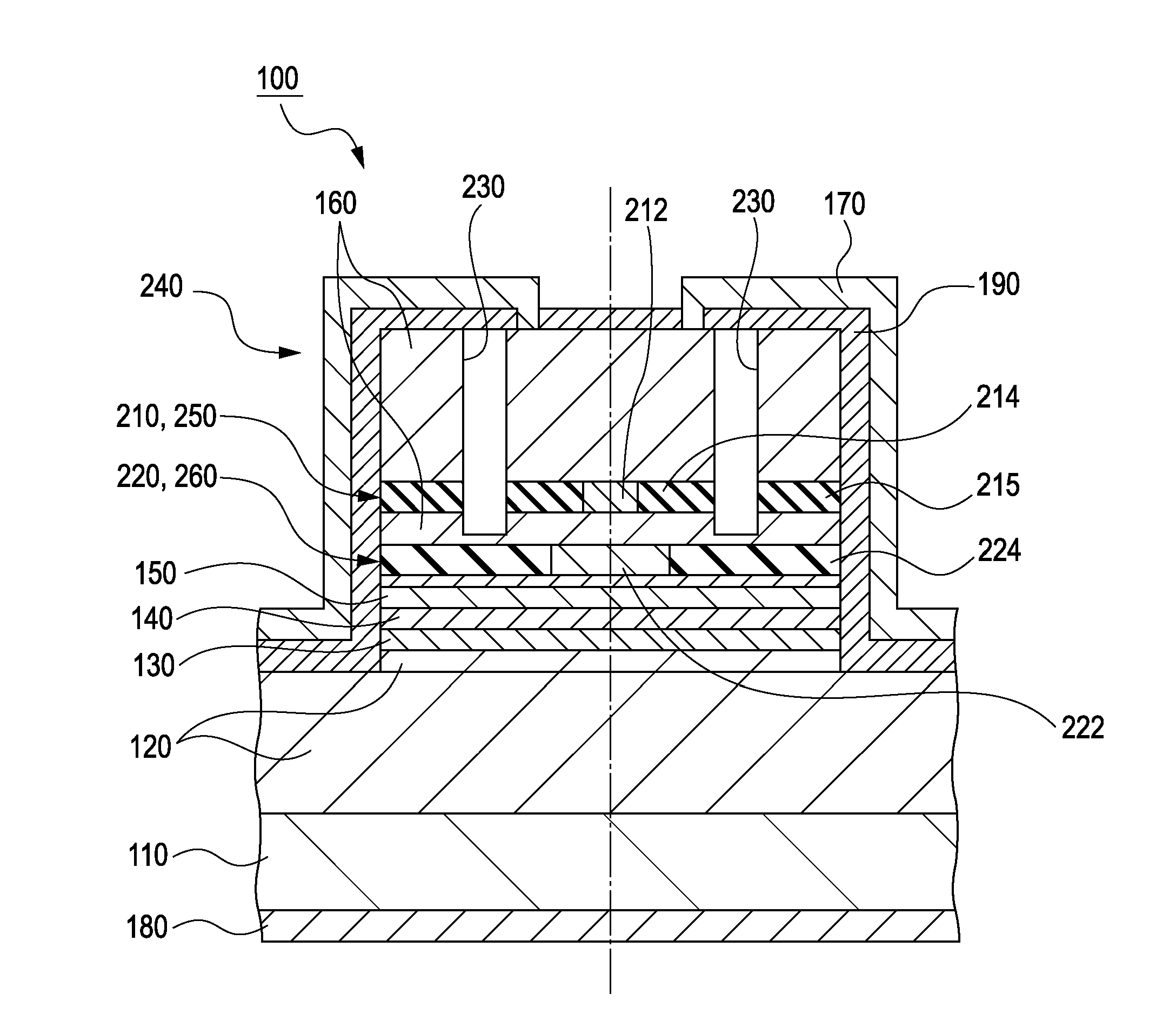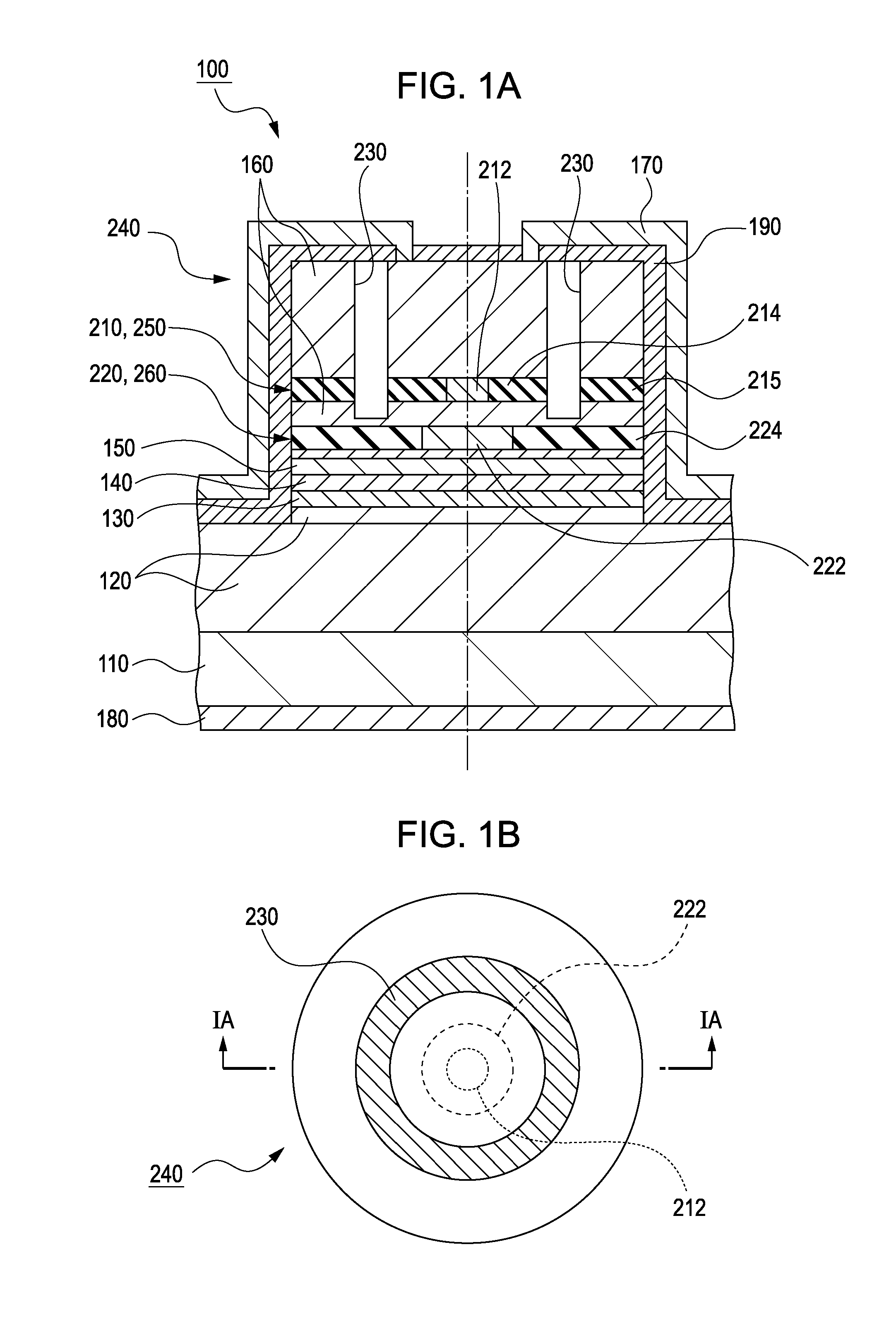Surface emitting laser with trenches to define conductive regions
a surface emitting laser and trench technology, applied in semiconductor lasers, instruments, recording devices, etc., can solve the problems of reducing the reliability of the resulting device and the yield, and achieve the effect of ensuring the reliability of the device and small preparation error
- Summary
- Abstract
- Description
- Claims
- Application Information
AI Technical Summary
Benefits of technology
Problems solved by technology
Method used
Image
Examples
first embodiment
[0032]FIG. 1A is a schematic cross-sectional view of a surface emitting laser 100 according to a first embodiment of the present invention, and FIG. 1B is a schematic top view of the surface emitting laser 100. Specifically, FIG. 1A is a cross-sectional view taken along line IA-IA in FIG. 1B.
[0033]A lower multilayer mirror 120, a lower spacer layer 130, an active layer 140, an upper spacer layer 150, and an upper multilayer mirror 160 are stacked on a substrate 110 in that order to form a laser cavity in a direction perpendicular to a substrate surface. Carriers (electrons or holes-depending on the type of doping) are injected from an upper electrode 170 provided on the upper multilayer mirror 160 and a lower electrode 180 provided below the substrate 110 into the active layer 140. The active layer 140 emits light, thus leading to the oscillation of the surface emitting laser 100.
[0034]A first current confinement layer 210 is provided in the upper multilayer mirror 160. The first cu...
second embodiment
[0128]FIG. 7A is a schematic cross-sectional view of a surface emitting laser according to a second embodiment of the present invention, and FIG. 7B is a schematic top view of the surface emitting laser according to the second embodiment of the present invention. Specifically, FIG. 7A is a cross-sectional view taken along line VIIA-VIIA in FIG. 7B. Components that are common to those in the first embodiment are assigned the same reference numerals shown in FIGS. 1A to 6; thus, repetitive description thereof may be omitted.
[0129]A feature of the second embodiment is that a first trench structure 230 is divided into a plurality of portions. Therefore, carriers can flow into a first electrically conductive region 212 also from a region located above a first current confinement layer 210 and outside the first trench structure 230 when viewed from the central portion of an upper multilayer mirror 160 of the device. Accordingly, as shown in FIG. 7B, a contact region 175 can be formed even...
third embodiment
[0138]FIG. 8A is a schematic cross-sectional view of a surface emitting laser according to a third embodiment of the present invention. FIG. 8B is a schematic top view of the surface emitting laser according to the third embodiment of the present invention. Specifically, FIG. 8A is a cross-sectional view taken along line VIIIA-VIIIA in FIG. 8B.
[0139]As shown in FIGS. 8A and 8B, a third trench structure 280 can be provided on an emission aperture of the surface emitting laser of the first embodiment or the second embodiment. In FIG. 8B, a first electrically conductive region 212 is omitted for simplicity.
[0140]The third trench structure 280 has a function of providing an in-plane distribution of the reflectivity of an upper multilayer mirror 160, viewed from the active layer side, in a light-emitting region (specifically, in a second electrically conductive region 222). For this purpose, the third trench structure 280 is arranged inside the second electrically conductive region 222 i...
PUM
 Login to View More
Login to View More Abstract
Description
Claims
Application Information
 Login to View More
Login to View More - R&D
- Intellectual Property
- Life Sciences
- Materials
- Tech Scout
- Unparalleled Data Quality
- Higher Quality Content
- 60% Fewer Hallucinations
Browse by: Latest US Patents, China's latest patents, Technical Efficacy Thesaurus, Application Domain, Technology Topic, Popular Technical Reports.
© 2025 PatSnap. All rights reserved.Legal|Privacy policy|Modern Slavery Act Transparency Statement|Sitemap|About US| Contact US: help@patsnap.com



